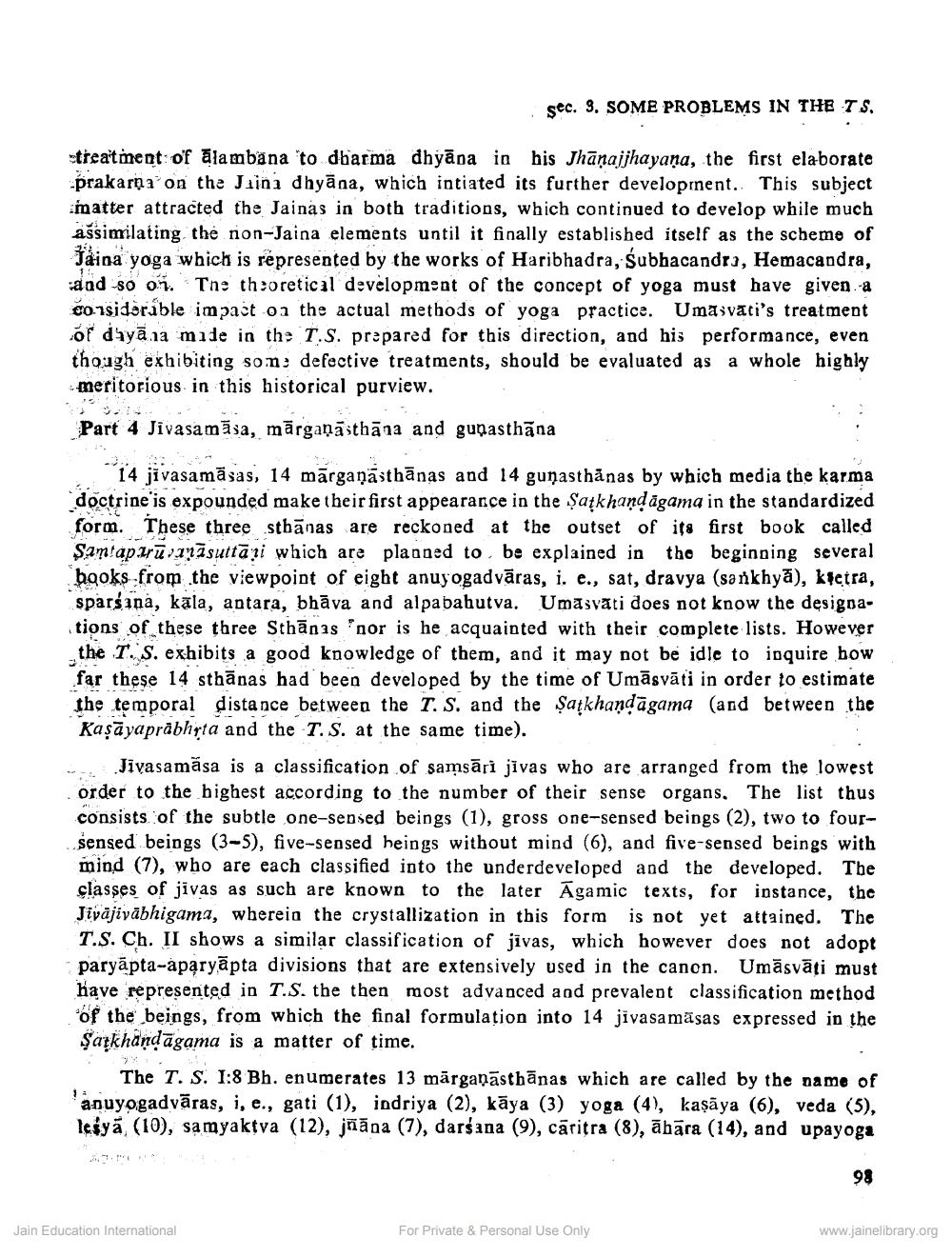________________
sec. 9. SOME PROBLEMS IN THE T S.
treatment of ajambana 'to dharma dhyāpa in his Jhānajjhayaņa, the first elaborate prakarna on the Jaini dhyāna, which intiated its further developrnent. This subject matter attracted the Jainas in both traditions, which continued to develop while much assimilating the non-Jaina elements until it finally established itself as the scheme of Jaina yoga which is represented by the works of Haribhadra, Subhacandra, Hemacandra, and so on. The theoretical development of the concept of yoga must have given a considerable impact on the actual methods of yoga practice. Umasvati's treatment of dayāna mide in th: T.S. prepared for this direction, and his performance, even though exhibiting som: defective treatments, should be evaluated as a whole highly meritorious in this historical purview.
Part 4 Jivasamāsa, mārgaņāsthāna and gunasthāna
14 jivasamāsas, 14 mārgaņāsthānas and 14 gunasthånas by which media the karma doctrine'is expounded make their first appearance in the Șaskhandāgama in the standardized form. These three sthānas are reckoned at the outset of its first book called Samtap.irūvanisuttāri which are planned to be explained in the beginning several books from the viewpoint of eight anuyogadvāras, i. e., sat, dravya (sankhyā), kteira, sparśana, kala, antara, bhāva and alpa bahutva. Umasvati does not know the designations of these three Sthānas nor is he acquainted with their complete lists. However the T. S. exhibits a good knowledge of them, and it may not be idle to inquire bow far these 14 sthānas had been developed by the time of Umāsvāti in order to estimate the temporal distance between the T. S. and the Șațkhandāgama (and between the
Kaşāyaprabhrta and the T. S. at the same time). - Jivasamāsa is a classification of samsāri jīvas who are arranged from the lowest order to the highest according to the number of their sense organs. The list thus consists of the subtle one-sensed beings (1), gross one-sensed beings (2), two to foursensed beings (3-5), five-sensed heings without mind (6), and five-sensed beings with mind (7), who are each classified into the underdeveloped and the developed. The classes of jivas as such are known to the later Āgamic texts, for instance, the Jivājivābhigama, wherein the crystallization in this form is not yet attained. The T.S. Ch. II shows a similar classification of jivas, which however does not adopt paryāpta-áparyāpta divisions that are extensively used in the canon. Umāsvāți must have represented in T.S. the then most advanced and prevalent classification method of the beings, from which the final formulation into 14 jivasamāsas expressed in the Şarkhandāgama is a matter of time.
The T. S. 1:8 Bh. enumerates 13 mārgaņāsthānas which are called by the name of anuyogadvāras, i, e., gati (1), indriya (2), kāya (3) yoga (4), kaşāya (6), veda (5), lesya (10), samyaktva (12), jñāna (7), darśana (9), caritra (8), ābāra (14), and upayoga
98
Jain Education International
For Private & Personal Use Only
www.jainelibrary.org




